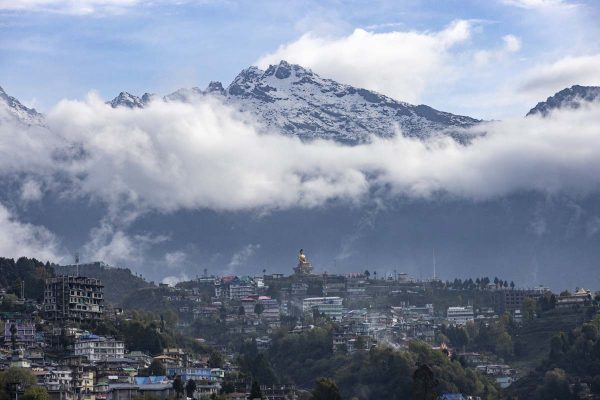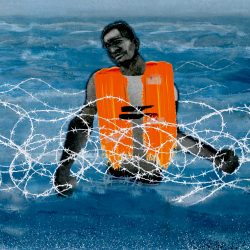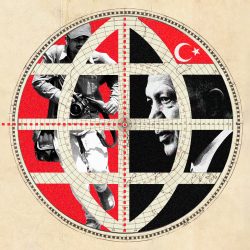
FEDERICO PARRA/AFP via Getty Images
How Venezuela lost its middle class
“I’m doing all types of jobs just to make ends meet,” says Giannina Fusco, a professor at the University of Carabobo, a public institution that serves tens of thousands of students mostly from central Venezuela. Teachers’ wages, the region’s lowest, have decreased by 95% since 1997 and few earn much more than $50 a month, far below a living wage.
Between January 9 and January 17 alone, teachers and professors led 400 protest marches across the country. It’s the latest in a long line of humiliations suffered by Venezuela’s educated, aspirational middle class and shows why so many millions are emigrating to pastures new.
Like many of her colleagues in Venezuela’s educated, professional middle class, Fusco has been driven to despair by low wages and terrible working conditions. She hasn’t bought clothes in two years and couldn’t pay for health insurance this year. “I’m having a hard time,” she told me. “I’m doing what I didn’t have to do when I started my career.” She describes a Venezuela in which some teachers wear shoes with holes in them, while others struggle to put nutritious, healthy food on the table. Some teachers, she told me, were moonlighting as security guards, others foraged for discarded fruits and vegetables at local street markets.
When an American NGO donated medicine to Fusco’s university, she says “around 70 professors asked for antidepressants.”
As salaries have collapsed, so have the budgets for state universities. According to Inírida Rodríguez, a professor and administrator at the Central University of Venezuela (UCV), these reduced budgets are part of policies by the governments of Hugo Chávez and his successor Nicolás Maduro aimed at exerting political control over autonomous public universities. Every aspect of university life is affected, said Rodríguez — with research equipment often obsolete and buildings left in disrepair. In 2008, the budget assigned to the university was almost 60% of what it asked; in 2021, it was only 2.3%. That year, part of a roof that covered a walkway on the university’s Caracas campus — a UNESCO World Heritage Site, extolled as a “masterpiece of modern city planning” — collapsed.
Over the last decade, the Central University of Venezuela’s student body has reduced by as much 60%, says Rodríguez, while the number of professors and courses on offer has reduced by about 30%. Other universities have been similarly gutted. Between 2015 and 2017, 430 professors left Simón Bolívar University, an institution focused on scientific and technological research and once among Latin America’s best.
The state of Venezuela’s universities reflects the wider animus between “Chavismo,” the ideology of the Chávez and Maduro governments that have ruled Venezuela since 1999, and the country’s professionals.
Chavismo’s hostility towards this class stems from its particular brand of socialism, argues the Venezuelan political scientist Guillermo T. Aveledo. Professional skills, if they’re not being used in service of the revolution, he says, are then seen “as serving the interests of capitalism and imperialism.” The Chávez and Maduro governments, Aveledo told me, prioritized ideological loyalty in state institutions over professional governance, over the language of efficiency and productivity. As the Venezuelan commentator, Francisco Toro acerbically observed nearly two decades ago: “For Chavismo, privilege always comes cloaked in a PowerPoint presentation.”


Growing control over education, including at university level, rising authoritarianism and the official encouragement of squatting turned the professional class — cosmopolitan and broadly liberal — against the Chávez government. In turn, adherents of Chavismo believed they needed to push critical professionals out of state institutions as a means to hold on to political power.
For example, the government moved to take control of public service companies, many of which had been turned by professional management into efficient and productive units by the late-1990s. “They removed professional managers and replaced them with obedient managers, and not necessarily highly skilled ones,” says José María de Viana, an engineer who led Hidrocapital, the public company that provides water in Caracas. De Viana was fired in March, 1999, soon after Chávez began his presidency, and was replaced by a Chavista engineer who would rise to become an important party member.
De Viana told me that the government “dismantled the internal corporate governance structures” of public companies like Hidrocapital, the Caracas Metro and Edelca, at the time the largest electric company in Venezuela. “This led to the destruction of the talent built over many decades in these companies,” De Viana says. “Human capital was lost.” The presidents of Edelca and the Caracas Metro were replaced by military men in 2002 and 1999 respectively. “The Bolivarian Revolution’s offensive ordered by President Chávez,” wrote Guillermo García Ponce, a director at a pro-Chávez newspaper, in 2003, “must mean the definite annihilation of the fifth column [that is] PDVSA, Edelca and the Caracas Metro.” PDVSA refers to Venezuela’s state-owned oil and gas company.
Two decades later, electricity and water shortages are widespread in Venezuela. According to the Venezuelan Observatory of Public Services, less than 30% of Venezuelans have regular water supply and even then the water sometimes comes out of the tap with a strange color and smell. Electricity rationing, essentially blackouts, that lasts for several hours is common in some states. Last year alone, Venezuela had 233,298 power cuts, according to the watchdog Committee of People Affected by Blackouts. In 2019, Venezuelans were forced to endure a weeklong nationwide blackout.
For De Viana, Edelca’s “twin” dams of Tocoma and Caruachi in the Venezuelan south illustrate the consequences of disregarding professionalism and expertise. Construction on Caruachi began in 1997, when Edelca still had its old corporate governance structure in place. The project took nine years to finish and cost $2.5 million dollars. Construction on Tocoma was started in 2007, a decade after construction began on Caruachi, and it remains unfinished and has already cost at least $10 billion dollars.
The project was mostly led by Odebrecht, a Brazilian company, which admitted it paid Venezuelan officials and middle men up to $98 million in bribes between 2005 and 2016 to secure contracts. Construction has now stalled on several of Odebrecht’s multi-million dollar projects in Venezuela.

Some argue that Chávez declared war on Venezuela’s professional classes in 2003 when he fired 18,000 employees from PDVSA, the national oil company, after they went on strike. “Venezuela had more registered patents per capita in the United States than almost any other country,” energy expert Francisco Monaldi told me. Most, Monaldi added, came from an institute within PDVSA that had 170 PhDs on staff.
While many Venezuelan public companies were characterized by clientelism and corruption, Monaldi insists PDVSA was both meritocratic and professional. “It was an island within a very different country,” he told me. After the mass firings, Monaldi says, “the company’s gray matter was lost.” The people that left, says Pánfilo Masciangioli, a researcher and manager who worked at the institute between 1982 and 2010, “were replaced with people who did not even know how important it was to publish a paper.” The institute, which had around 1,200 patents before 2003, went on to register only around 100 over the next ten years, Masciangioli told me.
Former PDVSA employees, fearing for their futures, left Venezuela. The number of Venezuelans living and working in the Canadian oil province of Alberta rose from 465 in 2001 to 3,860 within a decade. In Colombia, the influx of highly skilled PDVSA employees helped its national oil company almost double its oil production by 2011. “The full effects of the professional exodus from PDVSA,” Monaldi told me, “weren’t fully felt until a decade later. The company went from producing 3.2 million barrels per day in 2002 to 717,000 in 2022.”
Before the mass firings, Monaldi adds, it was expected that oil production would reach six million barrels per day in 2019. The collapse of PDVSA’s infrastructure, after years of neglect and mismanagement, has also resulted in the country having around seven oil spills per month, according to the Venezuelan Observatory of Political Ecology. In 2020, a massive oil spill affected a coastal national park known for its high levels of biodiversity. Two years later, turtles and birds washed up dead on the tourist beaches of Lechería in eastern Venezuela, where a spill had affected almost eight kilometers of coastline.
Similarly, between 2006 and 2011, under the direction of a Chavista zoologist, the Venezuelan Institute of Scientific Research saw “a systematic process of dismissals of researchers and assistant personnel” who were opposed to the government of Chávez. Former institute researcher Claudio Mendoza told me: “You were either fired or forced to retire.” Cultural institutions weren’t spared either. In January 2001, announcing a “cultural revolution,” Hugo Chávez fired the directors of 30 cultural institutions on live television.
Among them was Sofía Imber, who led the Museum of Contemporary Art in Caracas and had curated arguably the best modern art collection in Latin America. Culture had become elitist, said Chávez in justification of his decision. But for Lorena González Inecco, an art professor at the Metropolitan University in Caracas, this was the beginning of the “demolition” of public cultural institutions which included the elimination of institutional autonomy and the appointment of loyalists to top positions.
A larger wave of purges from public institutions happened after 2004, when the Venezuelan government compiled the Tascón List: a document with the names of the more than two million people who had signed a recall referendum against Chávez. The list was used to discriminate against those who had signed, including the firing of hundreds of workers from state institutions and companies.
Among these institutions was the National Library. Specialist departments became defunct. The library’s archives are decaying, says Mario Di Giacomo. He worked at the library for 20 years. “Dissent was not acceptable,” he told me, after the Chavistas took over. “It was a truly disgusting, traumatic and undignified process.”
Many professionals who once worked in public institutions and companies have now left Venezuela, joining an ever-growing diaspora of middle class Venezuelans who have escaped a deep economic and humanitarian crisis. In 2017 alone, 4,000 Venezuelan engineers moved to Argentina. By 2019, 21,000 engineers from Venezuela had moved to Peru.
Maduro became president in 2013, assuming office after the death of Chávez. Since 2015, over seven million people have left Venezuela, six million of them for other countries in Latin America. By 2025, over eight million people will have left Venezuela, or over a quarter of the country’s population as recorded in 2015. Their effect on the GDPs of the Latin American countries that absorb this influx of educated Venezuelans is expected to be positive.
Meanwhile, back in Venezuela, a presidential election is anticipated at some point next year. But observers and analysts have remarked on the growing political apathy in Venezuela, as the opposition flounders. Despite a fledgling economic recovery, over half of Venezuelans still live in poverty and the average monthly wage is a pittance.
Venezuela, with its significant oil reserves and its educated population, could have become a balanced, middle class society, political scientist Guillermo T. Aveledo has said. Instead, it is now riven with extreme inequality, with a fraction of people enjoying outsized wealth while the rest of the country struggles to stay abreast of inflation.
As Inírida Rodríguez, the professor and administrator at Central University of Venezuela, told me, there is a need for those who have remained in Venezuela to cling to optimism. “Many young people still come to our classrooms,” she said, “with their hopes resting on the university. And our professors, with effort and dedication, continue to support those hopes and dreams.”
The story you just read is a small piece of a complex and an ever-changing storyline that Coda covers relentlessly and with singular focus. But we can’t do it without your help. Show your support for journalism that stays on the story by becoming a member today. Coda Story is a 501(c)3 U.S. non-profit. Your contribution to Coda Story is tax deductible.













